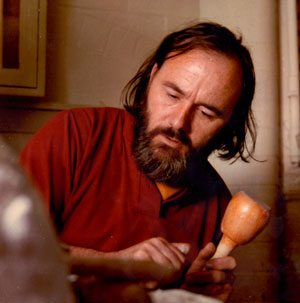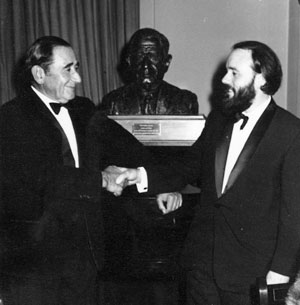Life story

Stuart John Osborne at Work
Stuart Osborne was born in Bristol in 1925, and grew up in the Somerset seaside town of Weston-super-Mare. There was nothing in his family background that would predict the artistic and educational course that his life and career would take – his father was an animal-feed salesman in Hereford, Gloucester, and South Wales, and his older brother managed a Woolworths shop. However, Osborne's precocious modelling talent as a child was soon recognised by the gift shops of Weston, where his animal models were sold to tourists. In turn, these models recommended, and helped to fund, Osborne's early entry into the West of England College of Art in Bristol.
Almost as soon as they started, these studies were interrupted in 1943, when the 18-year old Osborne volunteered to serve in the Second World War. During his initial training for the infantry, Osborne's artistic talent continued to attract attention from a number of his commanding officers, most notably from William Douglas-Home, for whom Osborne helped to design the stage settings for The Chiltern Hundreds. A lucky bout of scarlet fever spared Osborne service in the disastrous Battle of Arnhem, for which he had trained as a signaller. Instead, he was posted to India, where he served as an Education Sergeant for the latter part of the Second World War, and then as part of the forces overseeing British withdrawal.
After being demobbed in 1947, Osborne returned to Bristol to resume his studies at the West of England College of Art, but, both amusingly and frustratingly for the 22-year old, these studies had first to wait until he retook his School Certificate alongside that year's crop of 16-year olds (his original records having been destroyed in the bombings during the war). In 1952, after four years in Bristol, he was encouraged by one of his first mentors, Donald Milner, to submit his work to the Royal College of Art in London, where his talent was recognised immediately.
During his period at the RCA, Osborne's career began to develop apace, and his immense technical artistic ability began to be widely recognised. Jacob Epstein, who was a Visiting Professor at the RCA during 1952, selected Osborne to work with him for the year that Epstein was at the RCA. During that year, Osborne assisted Epstein with The Philadelphia Group, which subsequently was exhibited at the prestigious 3rd Sculpture International, at the Philadelphia Museum of Art.

Artist at an Unveiling
The next year, 1953, Osborne was selected as one of 12 finalists, to be exhibited at the Tate Gallery, in the Institute of Contemporary Art's Unknown Political Prisoner Competition, which had drawn more than 3,500 entries from over 50 countries. This world-wide competition commemorated those who sacrificed their freedom or lives for political ideals. Osborne's achievement of being included on the final list (beating his own Sculpture Professor, Dobson), alongside such notables as Butler, Frink, Gabo, Hepworth, and Pevsner, cannot be underestimated. However, the tide in the London art world was then turning against the figurative, and, rather than be forced in a direction that was not right for him, Osborne left London, working briefly in Bristol and Exeter, before moving to Stafford in 1956, to continue his work in the absence of distractions, and unwelcome intrusions, from modernism.
In Stafford, Osborne created one of the few figurative sculpture courses in the country, which he ran, single-handedly, until his retirement from teaching in 1990. This period was intensely busy, and, even given the massive effort that Osborne gave to his teaching, he found time to produce notable commissions for portraits (e.g., Pope John Paul II, Indira Gandhi), major pieces for tour (Bjorn Borg), and work for exhibitions at the Mall Galleries, and Covent Garden, in London. His art also continued to find international recognition, receiving invitations to exhibit in the Twin Towers in New York, in Paris, and also in Rome, where Osborne was offered the Silver and Gold Medals for Artistic Achievement by the Academy of Art.
On his retirement from teaching in 1990, over 80 of his former students arranged a party to celebrate his achievements. Following his retirement, Osborne never ceased working, and chose to express his career in focusing on creating figures and forms to his own satisfaction and to continue developing his outstanding skills.